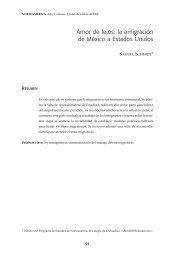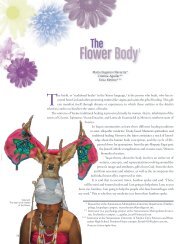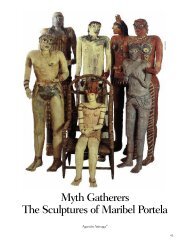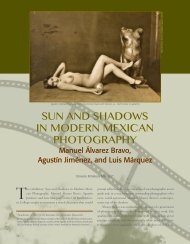Gerardo Suter
Gerardo Suter
Gerardo Suter
You also want an ePaper? Increase the reach of your titles
YUMPU automatically turns print PDFs into web optimized ePapers that Google loves.
<strong>Gerardo</strong><br />
<strong>Suter</strong><br />
Looking through <strong>Gerardo</strong> <strong>Suter</strong>’s eyes, the perception<br />
of the Mexico City horizon is limitless, like our expectations<br />
of possibly getting lost and meeting up again<br />
in that exploration. His approximations are perspectives that<br />
broaden the horizon, refracting it into faint fragments in which,<br />
crouched in the thickness of its layers, the atmosphere dresses<br />
in tonal suggestions, textures, and images that stroke our sense<br />
of touch as well as all the rest of our senses. These are surfaces<br />
whose irregularities challen ge the domain of machines<br />
in printing images because they continue to feel the heart<br />
*Curator and art critic.<br />
Photos courtesy of the Old San Ildefonso College.<br />
64<br />
Mexico<br />
City<br />
The Penultimate<br />
Region<br />
Ery Cámara*<br />
beats of a gestation process. Whether lead or copper captivating<br />
the density of grays and blacks without blurring the<br />
horizon, or vinyl canvases converted into the reflection of those<br />
billboards blighting Mexico City’s streets, <strong>Suter</strong>’s photography<br />
makes the supports active elements in the birth of the light<br />
that breathes life into these images: they give each so lution<br />
a singularity, as though they were the glue running through the<br />
intensities of that language, or, rather, the exhalations of those<br />
presences.<br />
Like a living organism, the city grows in all directions<br />
without noticing the imbalances its excessive expansion, its<br />
threatening seismic territory, and the effects of climate chan ge<br />
on its geography inflict. It traps us, and, like a flash of ligh tening,<br />
64
Spacelapse series, 100 x 200 cm, 2009 (inkjet on paper with acrylic protection).<br />
A horizon that cancels itself<br />
out at the same time that it engenders<br />
the need to re-situate itself, it opens<br />
up in front of us like an abyss<br />
that challenges our doubts.<br />
challenges our imagination and creativity in this be coming that<br />
the photographer presents us:<br />
If we see that new strata emerge throughout the city uninter<br />
ruptedly, and what we observe all the time is unfinished and in<br />
a continuous process of transformation, the presence of a penultimate<br />
region in Mexico City ends up being the rule and not<br />
the exception. A penultimate that appears in the surrounding<br />
areas, downtown, anywhe re in between, with different characteristics,<br />
depending on the place, but always there. 1<br />
In his constantly transfiguring landscapes, just like in our<br />
social habits, glances are exchanged, sheens like mira ges,<br />
reciprocal questions, indescribable doubts and rumors that<br />
palpitate or oscillate just like fireflies illuminating their own<br />
movement. An observer of the city’s mutations, the pho to grapher<br />
reveals and interprets this uninterrupted transformation<br />
that is sedimented in layers, strata, crumbling or peel ing<br />
walls; structures that are abandoned or undergoing some<br />
indeterminate process; buildings or urban clusters that tell<br />
65
66<br />
Refoundation series, 240 x 80 cm, 2008 (inkjet on cotton paper).<br />
<strong>Suter</strong> reveals and interprets<br />
this uninterrupted transformation<br />
sedimented in layers, strata; structures<br />
abandoned or undergoing some<br />
indeterminate process; buildings or<br />
urban clusters that tell us about the<br />
many cities that are amalgamated.<br />
us about the many cities that are amalgamated and interpe netrate<br />
in every renovation or just irrigate the imagination.<br />
Silhouettes and specters with reminiscences winking out at<br />
us from their compositions of transcendental stylistic trends<br />
in the evolution of photography.<br />
To reach the penultimate region, you have to cross over<br />
the enigmatic thickness of its clouds and the pollution that<br />
intensifies the details of the scenery, forcing us to focus how<br />
we perceive it differently. A horizon that cancels itself out at<br />
the same time that it engenders the need to resituate itself.<br />
It opens up in front of us like an abyss that challenges our doubts<br />
and stretches out before our concerns as we explore its territory.<br />
A region diffuse by nature, it holds surprises that attract<br />
<strong>Gerardo</strong>’s gaze and, through it is shot a creative sensibility<br />
whose culmination prefers to disappear among the subtle<br />
vibrations dissipated in the dynamism, the passion, and eloquence<br />
that emerges from the oeuvre. We are participants in<br />
the coming of the moment; the camera opens up a world<br />
whose heart looks, and its eyes reflect the awakening of the<br />
entire universe:<br />
The proposal points to revealing a city that has become a space<br />
trying to contain something uncontainable, growing in all directions,<br />
and that, when it touches any one of the four points of the<br />
compass, cancels its unfolding. And that is when the up or<br />
the down of Mexico City are spaces that can be colonized and<br />
turn into the penultimate region.<br />
Through photography, <strong>Gerardo</strong> <strong>Suter</strong> excavates the urban<br />
landscape from perspectives that the new arrangement of the<br />
streets facilitates; he flies over its heights to diagram its scenarios,<br />
gaps, and horizons with an invisible grid. He brings the<br />
faroff close and distances what is near to discern their connections,<br />
their points of contact, or their intervals. Each of<br />
these scales is named by the author, and that is how they<br />
revive the complexity of meanings that their austere presence
acquires over multiple uses. Any attempt at definition or<br />
normativity flounders because of the unforeseen nature of the<br />
manifestations of its space. In the eyes of the artist, the megalopolis<br />
becomes a miniature without mutilating its qualities;<br />
it sleeps, it becomes huge, and it awakens blurred. Its<br />
dreams are restored going through the sieve of the sensations<br />
they spark.<br />
Attentive to the reply, <strong>Suter</strong> knows that the outcome of a<br />
cataclysm cannot be foreseen. Its impact forces reconstructions,<br />
all charged with subjectivity. With his ability to strike<br />
the right note, dawn breaks over the region with a shuddering<br />
sun. His promenades are dialogues, relationships, frictions,<br />
social breaks that dig up unresolved conflicts and cracks,<br />
which will heal over who knows when. The scaffolding and<br />
towers, antennas, cables, and structu res invade every d i<br />
To reach the penultimate region, you<br />
have to cross over the enigmatic thickness<br />
of its clouds and the pollution<br />
that intensifies the details of the<br />
scenery, forcing us to focus how we<br />
perceive it differently.<br />
rection and trace abstractions and geometries that from the<br />
rooftops cut a piece out of the sky. Bursts of lines shoot captivating<br />
ambiguities that glide without sails in the panorama<br />
with echoes and reflections that unravel the weave of the illuminating<br />
gaze.<br />
<strong>Gerardo</strong> <strong>Suter</strong><br />
Scenario, 270 x 360 cm, 2008 (inkjet).<br />
67
<strong>Gerardo</strong> <strong>Suter</strong><br />
To the extent that the recognition of images advances,<br />
we are invaded by a feeling of witnessing a profound immersion<br />
that avoids the interferences of anecdote or pretext. The<br />
superposition of still and cinematic images, sediments of<br />
sound and of stimuli spread like the raging fog that makes an<br />
object of the repeated shot, invites us to peek into this new<br />
reality engendered by photography:<br />
68<br />
It should be said that the relationship between conceptual and<br />
formal development in each of my projects is fundamental. Defining<br />
a theme like an urban landscape of Mexico City, and pro<br />
Refoundation series, 145 x 185 cm, 2010 (inkjet on paper).<br />
The penultimate region promises nothing;<br />
it only respects the eclipse of the gaze, the blind shot<br />
that magnetizes the frame. <strong>Suter</strong>’s images appropriate reality<br />
to extract its essen ce and its paradoxes.<br />
blematizing with it both the imagedocument binomial and its<br />
location in the architectural space allows me to open up two<br />
parallel paths for reflection that join with the artistic or aesthetic<br />
result. There is, then, a triple interest that envelops the project:<br />
the focus and aesthetic solution adopted for its production, and<br />
finally, the reflection about the langua ge used for its representation<br />
in the specific space it occupies when it is exhibited.<br />
Careful in selecting formats, textures, and the different<br />
supports that make up the photographic language of his images,<br />
<strong>Suter</strong> experiments with resources, and plays and tests
the descent into the charged vacuums created by uncertain ty.<br />
The penultimate region promises nothing; it only respects the<br />
eclipse of the gaze, the blind shot that magnetizes the frame.<br />
<strong>Suter</strong>’s images appropriate reality to extract its essen ce and<br />
its paradoxes. Like a latent consistency, an evanescent density<br />
that shelters itself in the enigmatic penumbra, indiscernible<br />
because it is, paradoxically, a petrified instant of a reality<br />
charged with the emotions that capturing it brought out, the<br />
penultimate region evaporates before the light and takes refuge<br />
in shadow. The shot seems to be an unagreedupon<br />
date in which what is surprising is the familiarity and fresh<br />
In his constantly transfiguring landscapes,<br />
glances are exchanged, sheens like mira ges, reciprocal questions,<br />
indescribable doubts and rumors that palpitate or oscillate just<br />
like fireflies illuminating their own movement.<br />
Refoundation series, 120 x 120, 2009 (inkjet on paper with acrylic protection).<br />
way the landscape invades us through the windows <strong>Gerardo</strong><br />
<strong>Suter</strong> opens.<br />
The sensations caused by his atmospheres, in which presences<br />
throb and the tracks of intangible human dreams whisper,<br />
burst from the clearings that our approach announces.<br />
They hint at the juxtaposition of their distribution, and their<br />
glazes unhinge any predetermined logic. The penultimate region,<br />
like the lake that lies beneath it, does not cleave to any<br />
form, any color; it is a space where under these sublimated<br />
glazes, history is thoroughly analyzed, its vestiges steal a look<br />
to attend to the excitements of memory and the imagination;<br />
69
70<br />
Downtown, 240 x 80, 2009 (video photograms).
The penultimate region is the architecture of a process<br />
of the destruction-construction-deconstruction of a space that can be turned<br />
into a discursive resource in the field of poetry.<br />
<strong>Gerardo</strong> <strong>Suter</strong><br />
Spacelapse series, 115 x 295, 2009 (inkjet on paper with polycarbonate protection).<br />
layers begin to appear while others dissolve. On the surface,<br />
the photograph recovers the emotional breath that was exhaled<br />
at the moment it was taken. The breath of life, like a flash,<br />
impregnates the fog that says everything and hides nothing.<br />
The velocity convened in this meeting encapsula tes time and<br />
freezes its advance. And that becomes a tangi ble document<br />
that vindicates its visibility and demands a dynamic vision. The<br />
penultimate region is the architecture of a process of the destructionconstructiondeconstruction<br />
of a space that can be<br />
turned into a discursive resource in the field of poetry. A<br />
scaffolding of sequences and articulations that trace the ambiguity<br />
of this region that always presents itself as a promise.<br />
A space catalyzed by a sensation of progressive expansion<br />
that intimidates our expectations and our aspirations.<br />
A place from where one always aspires to reach the ultimate<br />
region, where the denseness of the gaps envelops all the questions<br />
suggested in the transit of the will to the next goal. Incor<br />
poreal figures barely sketched by the haze that blurs everything,<br />
the facades of these buildings inscribe the passage of time<br />
and the light in the infinite. They awaken from the darkness,<br />
hiding the complexity of the confrontation of what remains<br />
and what retreats. The past revives and the fu ture announces<br />
itself from their reminiscences. The public space absorbed in<br />
itself in this landscape multiplies its functions in the planes of<br />
this architecture of thoughtcumimage. It is a mirror where the<br />
gaze cancels any similarity to appreciate the transmigrations<br />
and the incessant confluences that weave this epiphany.<br />
notes<br />
1 All quotes are from <strong>Gerardo</strong> <strong>Suter</strong>, “Palimpsesto,” Essais, chroniques et<br />
Témoignages. Artelogie no. 2, 2012.<br />
71







